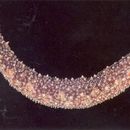Its numerous tube feet give
H. grisea a tenacious grip on hard substrates, and it cannot be pulled away from aquarium walls without damaging the feet. On the southeast coast of Florida, large numbers of these sea cucumbers are often associated with
Phragmatopoma lapidosa worm reefs, at least during the summer months. At one locality (Fort Walton rocks, near Fort Pierce), individuals disappear from the reefs during the winter, possibly migrating some distance offshore. In some localities, individuals are numerous in shallow lagoons, especially where marine grasses are abundant. During extreme low tides, these areas may be almost desiccated and the temperatures can exceed 35°C, but the holothuroids somehow are capable of tolerating the harsh conditions. A preliminary study of ovarian ultrastructure and
oogenesis in this species revealed features typical of several other holothuroids that have been similarly examined (Eckelbarger and Young 1992). However, the
oocytes of
H. grisea have highly branched
microvilli and
endocytotic vesicles, which may be involved in the uptake of nutrients during yolk production. Its pattern of
coelom formation during early development has also been studied, with surprising results (Balser et al. 1993). Although holothuroid larvae were thought to lack an axocoel, the auricularia larva of this and other species was found to possess an axocoel that is lined with mesothelial podocytes and is connected, by a duct, to a pore on the dorsal surface of the larva" (Hendler et al 287).

